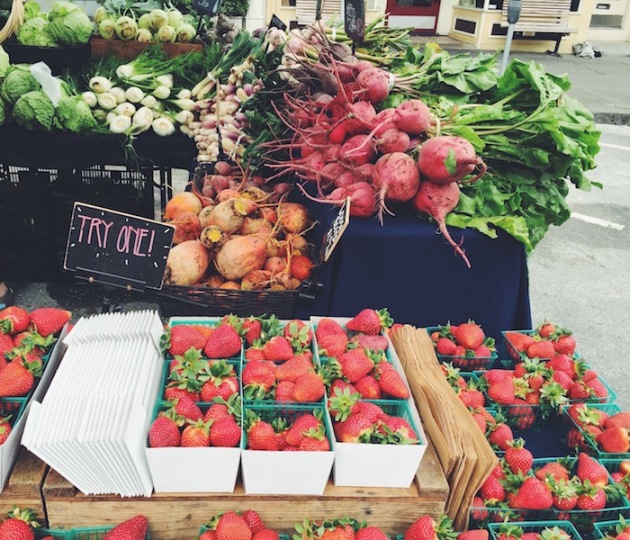
A few years ago, my partner and I began cooking at home together.
He and I decided—on a whim—to do a 30-day clean-eating challenge, which meant that we had to home-cook all of our meals and couldn’t drink alcohol for a month.
As young 20-something-year-olds, the idea of removing alcohol from our daily diets was more daunting than cooking 90 meals at home—despite takeout being a regular occurrence at the house.
It was definitely my idea—before we met, my partner sustained himself off of Domino’s and pasta. Not-so-secretly, my goal for the challenge was to lose weight. As a young woman, and in fact since I was 14, my goal has always been to lose weight—but that’s a different story for a different time. And sure, I might have shed a few pounds here and there at the end of the 30 days, but I stepped away from the challenge with so much more than better-fitting jeans. We had created 30 days of wonderful new memories.
We began by meal-planning together. We excitedly flipped through cookbooks and Pinterest boards for unique (and easy!) recipes without processed foods. We vetoed recipes with asparagus (which I despised, still do) and Brussels sprouts (for only a few days, because he came to love them after I made him my special sesame roasted Brussels sprouts).
Over those 30 days, we learned not only about the types of food that each other likes and dislikes, but also the foods that have a special place in our hearts.
I love salmon. I grew up on the West Coast with my dad, preparing grilled salmon alongside organic greens and some healthy starch—your go-to Californian dinner. Meanwhile, my partner put cumin on everything—eggs, potatoes, chicken, meatballs, cauliflower—the spice being a taste of his Moroccan roots. He introduced me to Louisiana Hot Sauce (now a staple at our house), and I showed him that you actually could make good spaghetti Bolognese with zucchini noodles.
Some nights, we’d dance in the kitchen while we waited for the water to boil. Other nights we’d prepare dinner silently because of a silly argument we didn’t mean. On those nights, we would still cook together, trying individually to make sense of our emotions. By the time we sat down at the table, we knew how to speak rationally and genuinely to each other.
Cooking had a way of allowing us to process the things in our life that we didn’t make space to do so in our otherwise busy days.
Most nights, he did the dishes—because I would usually do all of the cooking. Initially, it was the control freak in me who wanted to project-manage the entire process, but the more often we cooked, the more I realized how much I loved cooking. I found joy in unearthing new recipes, challenging myself to prepare them, and following this challenge through to completion. I relished being away from distractions—and specifically my phone, a portal to work that never stopped. I enjoyed the meditative qualities of chopping and stirring, and I loved being able to do something useful with my hands like peeling garlic rather than scrolling through Instagram. He saw that in me, so he did the dishes.
Only a few times did we concoct something semi-disgusting. I don’t even remember what the meals were or why they were terrible—whether it was the recipe itself or the fact that I defied to follow recipes to the teaspoon.
“This is gross,” I’d say.
“It’s not your best,” he’d sweetly reply, a feeble attempt to keep my feelings intact.
We’d laugh and disagree about whether it was edible or not. Usually, the meal would end with me browsing through the fridge for something else to eat, while he’d finish his plate to preserve my pride.
Most of the time though, we prepared delicious and healthy meals. It was eye-opening to learn that it wasn’t complicated or time-consuming to make a wholesome dinner for two.
Food isn’t just something we eat to survive or something that makes us fat. It’s a link to our heritage and our cultures. It’s a taste of home, a spoonful of nostalgia. It’s a vessel for connecting—for strengthening old relationships and starting new ones. Cooking, too, is a beautiful opportunity to put your phone down, get inspired, and use your creativity to create something.
There are all kinds of clean-eating challenges that you can try at home. Some last three days, others last a month. Some eliminate dairy, sugar, or meat; others eliminate all processed foods. If you’re thinking of trying one out, here are a few tips to get you started:
>> Identify why you want to take on this challenge: Whether it’s to eat healthier, spend more time with your spouse or family, or just learn a new skill; if you’re honest with yourself about your reasons from the start, you’ll have a much easier time sticking to the challenge.
>> Choose a challenge that works for your body and your schedule: If you have an active job like teaching, it’s probably not a great idea to do a juice detox, because your body needs the right amount of energy to survive the day.
>> Stop multitasking and enjoy what you made: No more scrolling while chewing. Get away from your desk at lunchtime. Block off an hour to eat dinner with your loved ones.
>> And perhaps the most important tip: Find someone to do the challenge with—a friend, a partner, a family member. This last point should not be discounted. It’s the best part.
Together, you get to embark on this exciting new adventure. You’ll get to work together to create delicious things. You’ll also get to support each other when one is feeling down—because there will be down moments when all you want is a damn cookie that your coworker baked for the office. And perhaps, most of all, you’ll form a more sincere bond as you learn about each other’s backgrounds, insecurities, and passions.
The best moments of our challenge together were when we’d go grocery shopping together, or I’d get a midday text from him: “Lunch was soooo good! You da best.” Or when I discovered a great new recipe for us try out. I loved to hug him from behind while he did the dishes. I’ll also never forget the smile on his face when I made something spectacular. Or those dinners that lasted hours—where we sat down, drained from the long day, and left the table rejuvenated after a delicious home-cooked meal and a stimulating conversation. It doesn’t take much, just a few ingredients.
In those 30 days, we grew individually, but also together. We learned more about how we function—how we like to work through issues and process challenges. We, of course, learned how to make a nice dinner, but we also rediscovered our kitchen as a beautiful space for togetherness.
We didn’t have to plan elaborate date nights to keep our relationship growing strong. We realized that we could discover new things about each other—that we could go on a new adventure—without ever leaving our own kitchen.
All we needed were a few fresh ingredients.
~
Author: Laura B. Childs
Image: Author’s Own
Editor: Catherine Monkman
Copy Editor: Callie Rushton
Social Editor: Nicole Cameron











Read 0 comments and reply